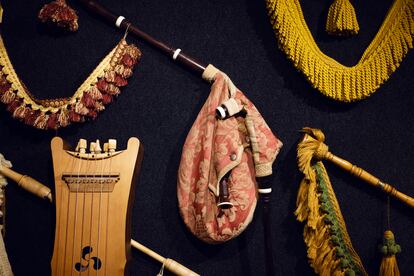“We all have a dream that repeats itself many times.
In my private home I see myself traveling through time and keeping bagpipes from all eras in a drawer”, confesses Pablo Carpintero Arias (Castro, Carballedo, Lugo, 53 years old) at the doors of the sanctum sanctorum of his Compostela home: the basement, lair or a bunker where any music lover would want to take refuge during a war.
The atmosphere here, on the same road on the outskirts of Santiago that leads to the Boisaca cemetery (home to illustrious people like Valle-Inclán), is that of a sacred pantheon, a hidden chamber in a pyramid, a treasure flanked by torches awaiting at the end of a passageway.
Although in this adventure, the relic-chasing hero is not called Indiana Jones and there are no snake traps, and the antechamber of fantastic space is not a secret corridor,
but only the garage of his house.
But on the other side of the back door, isolated from the world, there is a pagan temple with black upholstered walls on which hundreds of instruments unknown to most of the living dazzle, bathed in a dim golden light.
The main altar is occupied by the bellows bagpipes, like mythological beings with a very large stomach, dressed in embroidered silk, velvet, fringes and tassels, contemplating history from their pedestal.
Carpintero guards and plays dozens, perfect replicas of famous bagpipes from the northwest of the Iberian Peninsula, including that of the Pontevedra bagpiper Xan Tilve (1872-1950), who has been identified with a mathematical method as the oldest in the world.
Carpenter plays the bagpipes in his house.
The chanter —the tube with holes— is a replica of one from half a millennium ago. Ximena and Sergio
He builds them himself in an adjoining workshop from meticulous index cards where he records the measurements and details of each historic cleat to assure him at least the seven lives of a cat.
They are clones of instruments that became famous, “cult bagpipes” such as the guitar of a rock star, for which young pipers fought when their old player died.
Those whose magical sound transcended provinces, flooded the soul and took the party to all towns when there were no bands, radio, record player, orchestras that tour the summer festivals.
In addition to being a craftsman and a graduate in Advanced Studies in the History of Music, Pablo Carpintero has a doctorate in Biology and was a professor of Biochemistry at the University of Santiago.
In the lab he worked sequencing DNA and growing cells for bone regeneration.
"There are bagpipers out there with restored kneecaps," he smiles with satisfaction.
And it is that the legend says that the old pipers usually have a lot of life behind them.
In the lands where the bagpipe is the king instrument, its performers (always male) were once considered “people of the world”.
They had their status, "the good ones earned a lot of money", but the random life sometimes led to licentiousness.
Details of Pablo Carpintero's collection of instruments. Ximena and Sergio
And it is because of this that the investigator has found in his years of investigations some betrayed widow who ordered to destroy, burn to extinction, the instruments of her late husband, in which she focused on the infidelity suffered.
Other bagpipes, however, were lost because they stopped being played when the traditional tuning was changed to suit band instruments and sheet music.
Those old bagpipes were repudiated with a phrase repeated like a mantra by many later musicians: “Pull with that, it doesn't tune well”.
Some 15 years ago, “tired of waiting for a decent contract” and supported by his wife, Rosa Sánchez —who sings, dances and plays the drum—, the biologist decided to leave the test tubes behind.
It was to become a craftsman and dedicate himself fully to another passion to which he already devoted his weekends three decades ago, in his last Biology courses: to investigate traditional music and capture it with the discipline and methods of the exact sciences.
His latest discovery, now, feeds what will be his second doctorate, the History thesis that he plans to defend at the beginning of 2023 at the University of Vigo.
The mathematical calculation allows to know the age of a bagpipe by the wear of the holes of the pointer.
For this he had the help of his father, a former professor of Mathematics in Santiago.
But above all, from his faithful friend Iván Area,
also professor, of Applied Mathematics, at the School of Aeronautical Engineering of Vigo.
Area is a musician, fellow bagpiper fatigue and director of Carpintero's thesis together with the History teacher Susana Reboreda.
The surname of his subject, "applied", explains that in recent years, on his work table, the linear graphs that measure the seniority of a pointer coexisted with the forecasts of the evolution of the covid-19 in the Galician population.
The hands of Marilé Salgueiro Tilve and her grandson hold a bagpipe with the original chanter of their bagpiper ancestor Xan Tilve de Campañó. Ximena and Sergio
The section of a new pointer is round.
But a very old one, which has been played generation after generation, shows considerable flattening around the holes.
"It's the same as a ladder that was climbed and lowered for many decades," he puts for example.
"Or the footprint of the Pórtico de la Gloria", that deep mark of five fingers engraved by pilgrims of many centuries in the marble column of the mullion.
At the cost of replicating mythical bagpipes down to the smallest detail, Carpintero hypothesized that the unknown age of the bagpipes could be solved mathematically.
And he verified that, indeed, "90% of the wear was due to use, and only 10% to other variables", such as the type of wood.
With Iván Area, through graphs in which the vertical coordinate was wear and the horizontal was years,
Two are in the Portuguese capital.
That of Tío Pepe da Freixenosa (Trás-os-Montes), preserved in the National Museum of Ethnology, and an ebony and ivory chanter, in the hands of a private individual.
But the most ancient, as long as it does not appear and another previous one that steals the first place on the podium is documented, is that of Xan Tilve de Campañó, kept in Pontevedra as a family treasure by Marilé Salgueiro Tilve, a descendant of the legendary piper.
To confirm that the mathematical model, based primarily on the wear-and-tear variable, was correct, the university commissioned carbon-14 tests on samples taken from the oldest pointers in a Florida laboratory.
The result underpinned the calculations: the wood of the Campañó bagpipe, which according to the graph was played for at least 490 years, in use since the Middle Ages,
Pablo Carpintero works in his workshop. Ximena and Sergio
Carpintero does not know in the world a more exhaustive investigation regarding an instrument, and he says, recalling Tolkien, that it is thanks to the "Company of the Ring": a dense network of friends who arrive like capillaries to the most remote villages and notify him , for 30 years, of old pipers who need to be recorded before time takes them away.
The first he visited was Manuel Lago, from Carelle (Sobrado, A Coruña).
"I was blown away," he remembers.
"He was an absolutely exceptional bagpiper, who played a bagpipe with a fol made from a truck tire."
So he told his friend Iván, and this lover of algorithms responded with a round number: "We have to record 100 bagpipers."
They missed out on this mission.
Against the evil of historical oblivion, they have recorded (or as Carpintero says, “totally extracted blood”) the unique knowledge and melodies of 165 pipers, almost all of whom are deceased today.
In addition, they have rescued 170 different traditional instruments, including those made by children from the preintendence and pre-television era, such as goat horn flutes, cornstalk violins or chestnut bark bugles.
Over time, Carpintero published several books, including the award-winning Os musical instruments in the Galician tradition (2009), and was named a UNESCO consultant on intangible cultural heritage.
But the adventure of this Indiana without a whip has not come to an end.
Carpintero continues to dream of traveling to the past of a culture of "bestial roots", and feels that,
50% off
Exclusive content for subscribers
read without limits
subscribe
I'm already a subscriber















